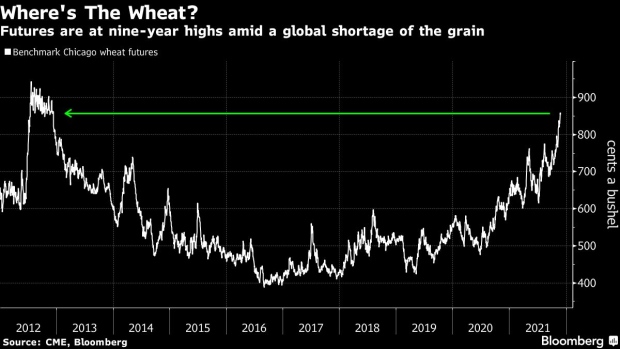Badly Timed Rain Hurts Australian Wheat When World Needs It Most
, Bloomberg New
(Bloomberg) -- Those fretting about the global scarcity of high quality wheat have one more reason to worry: heavy rains at the wrong time in Australia, one of the world’s biggest exporters of the grain.
Just as farmers were set to head into the fields and pull off a bumper harvest, sheets of heavy rain have battered crops across major growing regions in the country’s east, bogging down machinery and raising the risk of hefty downgrades that are likely to worsen a worldwide shortage of milling wheat.
The torrential downpours are typical of a La Nina weather event, which the Australian Bureau of Meteorology said on Tuesday had now commenced. The phenomenon brings above average rainfall to eastern and northern areas of Australia and to Southeast Asia, and dry weather to parts of the Americas.
“There’s no doubt that everyone is downgrading wheat, to the point where we are going to get 200% to 300% more feed wheat than a normal year,” said Ole Houe, chief executive of IKON Commodities. New South Wales state would be facing the greatest losses with around 30%-40% of total output at risk of being low-grade animal feed -- up from around 8% in a normal year, he said.
Still, Australia is on track to produce a record 37 million tons of wheat this season, according to IKON, with output from Western Australia largely unaffected by the torrential rains. If conditions remain the same during the season, only 15%-20% of the national crop is likely to be downgraded to feed, said Houe, who added that even the feed will be met with “plenty of demand.”
“Will it reduce our exports? Probably not. Will it keep prices high for the quality? Yes it will,” he said. “Is it a big deal? You betcha.”
IKON’s forecast for wheat production is above some other predictions. The U.S. Department of Agriculture, for example, estimates the crop at 31.5 million tons, down from last year’s record 33 million tons, but still one of the largest ever.
While the damage doesn’t yet look quite as bad as the downpours in 2011, which resulted in severe downgrades to around 75% of the New South Wales crop, a dearth of higher-quality supplies globally has led to the market banking on the Australian harvest for relief, with a particular focus on the east coast which tends to grow varieties with higher protein content than western regions.
The red hot demand has pushed benchmark prices in Chicago to multi-year highs. Meanwhile, the deteriorating situation is driving up prices Down Under, with futures for Eastern Australia Wheat jumping to the highest since 2019.
“The general protein-quality profile of the actual crop is lower than a normal year and in many years that doesn’t matter,” Houe said. “But given we’ve lost access to a lot of the Russian grain this year, we had trouble with the Canadian crop, we were kind of looking at Australia for this high-protein wheat.”
©2021 Bloomberg L.P.
No comments:
Post a Comment